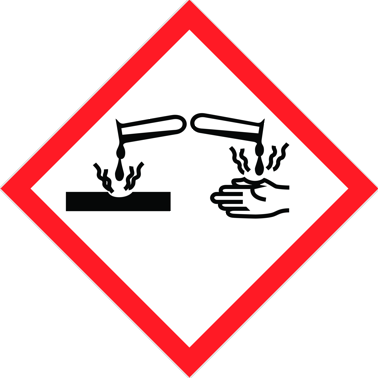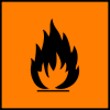x
Hazard Statements

GHS02
Flammable
- Flammable gases, category 1
- Flammable aerosols, categories 1, 2
- Flammable liquids, categories 1, 2, 3
- Flammable solids, categories 1, 2
- Self-reactive substances and mixtures, types B, C, D, E, F
- Pyrophoric liquids, category 1
- Pyrophoric solids, category 1
- Combustible solids, category 3
- Combustible liquids, category 3
- Self-heating substances and mixtures, categories 1, 2
- Substances and mixtures, which in contact with water, emit flammable gases, categories 1, 2, 3
- Organic peroxides, types B, C, D, E, F

GHS05
Corrosive
- Corrosive to metals, category 1
Safety & Transport Information
A low-melting alloy of Na and K. Its toxicity is due to either Na or K alone. Corrosive to the eyes, skin, and mucous membranes. Upon contact with moisture it reacts violently to evolve H2; much heat; and a highly caustic residue of NaOH or KOH. Oxidation forms Na2O and K2O, which are powerful caustics.A dangerous fire and explosion hazard. Violent or explosive reaction with O2, water, moisture, steam, halogens, oxidizers, acids or acid fumes, giving off much heat, hydrogen, toxic and corrosive fumes, often spattering either red-hot particles or actually flaming particles. A severe explosion hazard, will react explosively under the appropriate conditions with moisture, acids, acid fumes, solid CO2, carbon disulfide, halocarbons (e.g., CH3Cl, carbon tetrachloride, chloroform, bromoform, 1,1,1-trichloroethane, 1,1,2-trichlorotrifluoroethane, tetrachloroethane, CH2Cl2, CH2I2), ammonium sulfate + NH4 + NO3, HgO, metal halides (e.g., silver halides, zinc chloride, iron(III) chloride), metal oxides (e.g., silver oxide, mercury oxide), nitrogen-containing explosives (e.g., ammonium nitrate, ammonium sulfate, picric acid, nitrobenzene), oxalyl bromide, oxalyl chloride, pentachloroethane, K oxides, KO2, Si, NaHCO3, polytetrafluoroethylene. Reacts vigorously with oxidizing materials.To fight fire, use G-1 powder, dry sodium chloride, dry sodium carbonate, dry calcium carbonate, dry sand, resin-coated sodium chloride, or dry soda ash. Never use water, graphite, carbon dioxide, halocarbons, or foam.Dangerous; when heated it emits highly toxic fumes of Na2O and K2O. Used as a liquid coolant for nuclear reactor cores. See also SODIUM and POTASSIUM.
Risk Codes:
R11 - Highly flammable
R14/15 - Reacts violently with water, liberating extremely flammable gases
R15 - Contact with water liberates extremely flammable gases
R34 - Causes burns
Safety Codes:
S16 - Keep away from sources of ignition - No smoking
S26 - In case of contact with eyes, rinse immediately with plenty of water and seek medical advice
S27 - Take off immediately all contaminated clothing
S36/37/39 - Wear suitable protective clothing, gloves and eye/face protection
S43 - In case of fire use ... (indicate in the space the precise type of fire-fighting equipment. If water increases the risk add - Never use water)
S45 - In case of accident or if you feel unwell seek medical advice immediately (show the label where possible)
Hazard Symbols:
F, C


RID/ADR certification :
UN 1422 4.3 / PG 1
x
Alternative Distributors of [Sodium-potassium alloy]
Producers or manufacturers change the product range from time to time.
The following companies
have appeared as suppliers in the past / currently not verified
Camida Limited | ABCR GmbH & Co. KG








 Chemical-Suppliers.eu
Chemical-Suppliers.eu